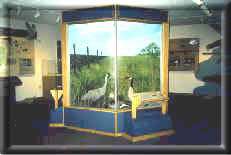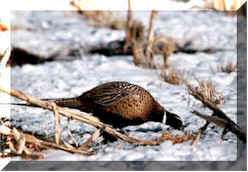Quivira National Wildlife Refuge, KS
For untold years, the ancient Big and Little Salt Marshes have attracted thousands of migrating waterfowl, providing them with food, cover, and a place to rest during exhausting flights between breeding and wintering areas. Indians and early settlers hunted the waterfowl in these marshes, and shortly after the turn of the century, commercial hunting provided wagonloads of waterfowl to Kansas City restaurants and other eastern points.
With the decline of commercial hunting came the establishment of hunting clubs whose acquisition of private lands helped preserve valuable waterfowl habitat from further development. Moreover, these clubs worked to improve the habitat -- among their attempts is the channel permitting Rattlesnake Creek to flow directly into Little Salt Marsh. Additional canals were dug later, proving the entire area with a more dependable water supply.
Today these marshlands remain a major stopover for thousands of migrating birds.
Quivira National Wildlife Refuge is 22,135 acres of prairie grasses, salt marshes, sand dunes, canals, dikes, and timber. Quivira is named for a tribe of Indians who were visited by Coronado in 1541.
A system of 21 miles of canals and 25 miles of dikes provides nearly 6000 acres of managed wetlands and marshes. Little Salt Marsh and Big Salt Marsh are ancient basins that have seen hundreds of thousands of water-fowl arriving for food, cover, and a place to rest on migration trips. During spring migration QNWR becomes a staging area for 500,000 birds.
Mammals prosper here and enjoy protection, food and a quiet lifestyle. Reptiles and amphibians abound along with resident bird species and those passing through to complete cycles of life. Quivira is a quiet, almost-never-see-a-human experience enjoyed by naturalists, photographers and wildlife lovers.




